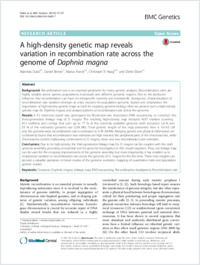A high-density genetic map reveals variation in recombination rate across the genome of Daphnia magna
- Dukić, Marinela University of Basel, Zoological Institute, Basel , Switzerland
- Berner, Daniel University of Basel, Zoological Institute, Basel , Switzerland
- Roesti, Marius Centre d’Ecologie Fonctionnelle et Evolutive, Université de Montpellier, Montpellier, France - Department of Biology, Ecology and Evolution, University of Fribourg, Switzerland
- Haag, Christoph R. Biodiversity Research Centre and Zoology Department, University of British Columbia,Vancouver, Canada
- Ebert, Dieter University of Basel, Zoological Institute, Basel , Switzerland
-
2016
Published in:
- BMC Genetics. - 2016, vol. 17, p. 137
English
Recombination rate is an essential parameter for many genetic analyses. Recombination rates are highly variable across species, populations, individuals and different genomic regions. Due to the profound influence that recombination can have on intraspecific diversity and interspecific divergence, characterization of recombination rate variation emerges as a key resource for population genomic studies and emphasises the importance of high-density genetic maps as tools for studying genome biology. Here we present such a high-density genetic map for Daphnia magna, and analyse patterns of recombination rate across the genome.Results: A F2 intercross panel was genotyped by Restriction-site Associated DNA sequencing to construct the third-generation linkage map of D. magna. The resulting high-density map included 4037 markers covering 813 scaffolds and contigs that sum up to 77 % of the currently available genome draft sequence (v2.4) and 55 % of the estimated genome size (238 Mb). Total genetic length of the map presented here is 1614.5 cM and the genome-wide recombination rate is estimated to 6.78 cM/Mb. Merging genetic and physical information we consistently found that recombination rate estimates are high towards the peripheral parts of the chromosomes, while chromosome centres, harbouring centromeres in D. magna, show very low recombination rate estimates.Conclusions: Due to its high-density, the third-generation linkage map for D. magna can be coupled with the draft genome assembly, providing an essential tool for genome investigation in this model organism. Thus, our linkage map can be used for the on-going improvements of the genome assembly, but more importantly, it has enabled us to characterize variation in recombination rate across the genome of D. magna for the first time. These new insights can provide a valuable assistance in future studies of the genome evolution, mapping of quantitative traits and population genetic studies.
- Faculty
- Faculté des sciences et de médecine
- Department
- Département de Biologie
- Language
-
- English
- Classification
- Biological sciences
- License
-
License undefined
- Identifiers
-
- RERO DOC 278412
- DOI 10.1186/s12863-016-0445-7
- Persistent URL
- https://folia.unifr.ch/unifr/documents/305335
Statistics
Document views: 197
File downloads:
- pdf: 233
